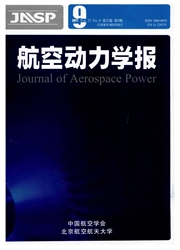

 中文摘要:
中文摘要:
为研究蒸汽流量对蒸汽直接接触凝结及汽泡表面变化过程的影响,利用高速摄像仪记录一定过冷度、不同蒸汽流量条件时过冷水中蒸汽的凝结过程.实验结果表明:蒸汽流量小于0.36m~3/h时,汽泡表面始终较光滑;当蒸汽流量升至0.74m~3/h时,汽泡表面上出现波动,汽泡最终逐渐分裂成数个小汽泡;当蒸汽流量大于1.13m~3/h时,汽泡表面上的波动非常剧烈,汽泡不稳定性增强,并最终破碎成大量微汽泡.且随蒸汽流量增,这些微汽泡的直径减少,喷射速度增加.蒸汽流量超过1.13m~3/h后,汽泡在凝结时,其相对半径迅速减小,半径变化率迅速增加.汽泡表面剧烈的波动会极大的增加汽泡有效换热面积,导致蒸汽与过冷水间的传热和传质过程被极具的加强.
 英文摘要:
英文摘要:
In order to investigate the effect of vapor injection rate on the direct contact condensation and evolution of vapor bubble surface, a high-speed video camera was employed to record the process of vapor condensation in the cold bulk at a certain liquid subcooling and different vapor injection rates. Experimental results showed that the bubble surface was rela tively smooth throughout the whole slow process of bubble condensation when the vapor in jection rate was less than 0.36m3/h. As the vapor injection rate increased to 0.74m3/h, sur face wave appeared on the bubble surface and the bubble was split up into some tiny bubbles finally. When the vapor injection rate was larger than 1.13m3/h, surface wave on the bubble was very violent. The bubble instability was enhanced and the bubble would collapse into many microbubbles. Furthermore, with the increase of the vapor injection rate, the diameter of these microbubbles decreased and the average velocity increased. When the vapor injection rate exceeded 1.13m3/h, the bubble relative radius decreased and the change rate of bubble radius increased rapidly. The strong surface wave on the bubble could increase the bubble cffective area of heat transfer significantly, resulting in a substantial enhancement of heat and mass transfer between vapor and cold bulk.
 同期刊论文项目
同期刊论文项目
 同项目期刊论文
同项目期刊论文
 Effects of void fraction correlations on pressure gradient separation of air–water two-phase flow in
Effects of void fraction correlations on pressure gradient separation of air–water two-phase flow in Comparison of local interfacial characteristics between vertical upward and downward two-phase flows
Comparison of local interfacial characteristics between vertical upward and downward two-phase flows Local interfacial parameter distribution for two-phase flow under rolling conditions using a four-se
Local interfacial parameter distribution for two-phase flow under rolling conditions using a four-se Effect of rolling motion on transient flow resistance of two-phase flow in a narrow rectangular duct
Effect of rolling motion on transient flow resistance of two-phase flow in a narrow rectangular duct Investigation of the interfacial parameter distribution in a bubbly flow in a narrow rectangular cha
Investigation of the interfacial parameter distribution in a bubbly flow in a narrow rectangular cha A theoretical analysis about the mechanism of the effect of rolling motion on single-phase flow resi
A theoretical analysis about the mechanism of the effect of rolling motion on single-phase flow resi Effects of void fraction correlations on pressure gradient separation of air-water two-phase flow in
Effects of void fraction correlations on pressure gradient separation of air-water two-phase flow in Evaluation of interfacial area transport equation in vertical bubbly two-phase flow in large diamete
Evaluation of interfacial area transport equation in vertical bubbly two-phase flow in large diamete Model of bubble velocity vector measurement in upward and downward bubbly two-phase flows using a fo
Model of bubble velocity vector measurement in upward and downward bubbly two-phase flows using a fo 期刊信息
期刊信息
